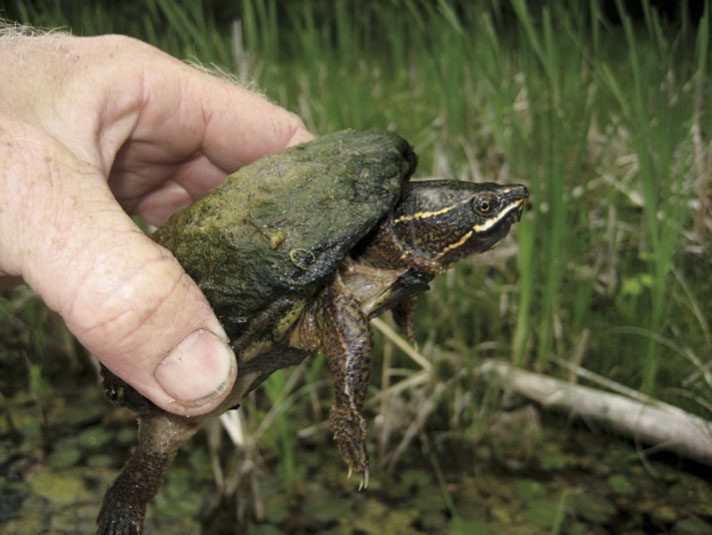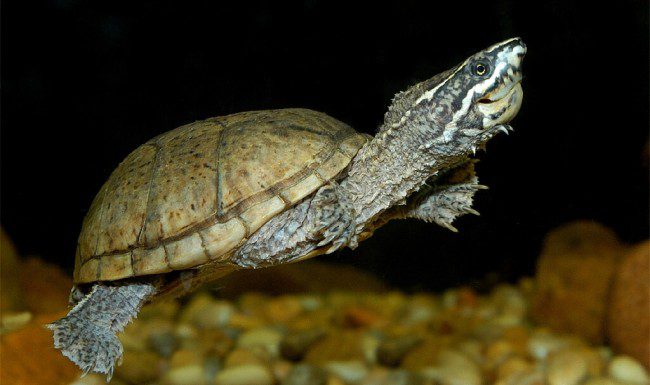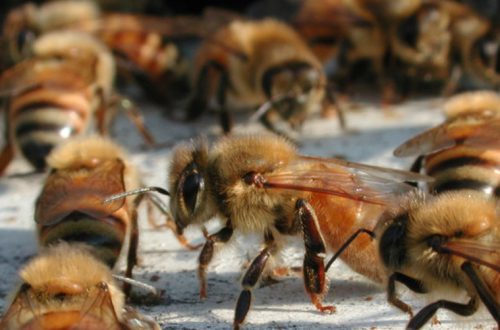
Keeping a musk turtle at home
Musk turtle is a great gift for those people who dream of having an exotic pet, but do not have experience in keeping this kind of living creatures. These turtles feel great at home, they are easy to care for, they are cute. And having learned how long they live – and they live for 25-30 years – people are completely delighted, because not all pets are able to please for so long. But first things first.
Contents
Musk turtle: how she looks like
So, First, let’s go through the outer characteristics of this reptile:
- Musk turtle quite small – its size in length usually ranges from 8 to 10 cm. However, you can also meet an individual 14 cm long, but these are the largest representatives, not always it turns out to find such turtles.
- Carapace – that is, the upper part of the shell – oblong, has oval outlines. It is smooth, but this is true in mostly for older people. young growth has fairly pronounced ridges. There are three of them, they are located longitudinally. So over time, the ridges disappear.
- Abdominal shield – plastron – has different sizes depending on gender. But anyway The plastron has 11 shields, as well as single link. By the way, the link be barely noticeable. Connection mobile, but hardly musk turtles can be called the owners of good range of motion.
- Small the secret of how determine sex: most often in males the plastron is shorter, but the tail longer and more powerful than females. In addition, females have a sharp end of the tail, in males it is blunt. Also, if you look to the hind legs from the inside, you can see scales-thorns, if speech it’s about males. Such outgrowths are needed for so that during mating the female could be fixed so that it does not ran away. Incidentally, it was previously thought that These scales help turtles to emit chirping sounds, but that’s a guess found no confirmation.
- neck of these reptiles is long, mobile. And it is so long that the turtle can easily reach own hind legs.
- That as for the color, then the shell of the musk turtles monophonic dark color. It can be called black or dirty brown. Neck, head and legs also dark. However, at the same time on the head and neck contrasting light stripes stand out, located along.
- Summary distinctive feature of this species from others – special glands located under the shell. В moments of danger from them stands out a secret with a sharp repulsive smell. With this secret, which and gave the name to such a breed of turtles, reptiles and scare off enemies.
Content Muscovy turtle at home conditions: what is it worth know
Despite on what the musk turtle is considered to be one of the easiest to maintain there are still nuances that are important know:
- An aquarium for such turtles needs to be chosen deep. The fact is that in their natural habitat – in the waters of the United States and sometimes Canada – they spend so much time in the water that they are overgrown with algae no worse than snags. Preferably, the capacity is at least 60 liters. The bottom plane should be approximately 80×45 cm. But it should be taken into account that if young individuals live in the aquarium, they do not need much water, since they have not yet learned to swim well.
- But even for adults, you do not need to fill the aquarium to the brim – they also need dry land! So, the perfect solution would be to equip a special island for relaxation. In some sources, you can find information that musky turtles do not need land as much as, for example, red-eared ones, but it is still better not to adhere to this information. On such a platform, the turtle will be able to warm up, dry out. But at the slightest sign of danger, the turtle will instantly dash down into more familiar water, where it is mobile and graceful. Be sure to make a gentle descent from land to water, so that the pet effortlessly climbs it.
- The bottom must be covered with river sand, previously well washed. Gravel may also occur, but only if it is fine. By the way, gravel and sand can also be poured on the island! You can even build a small sandbox – turtles love to rummage in it, and even those like musky. It is quite possible that in such sand they will eventually make masonry if they like this place.
- Any shelters and snags are highly desirable, given that turtles love to spend time in the water. In such places, they will be able to hide, as well as climb up them in order to take a breath of fresh air.
- As for greenery, some sources write that it is not needed, but in fact it is highly desirable. Thanks to the vegetation, the water will become better. But it is important to consider that the turtle often digs up the soil, so the plants should be planted in small pots initially, and then the pots – in the ground.
- Speaking of rumors: there is an opinion that an ultraviolet lamp is not necessary for musk turtles. But in fact, it is better to install it, as it allows you to disinfect the water. And for the turtle itself, a portion of ultraviolet radiation will be useful.
- The water temperature must be set within 22-26 degrees. Although, however, it can reach up to 20 degrees – this is not critical. The air temperature should be about the same.
- There must be a good filter. Given that turtles like to dig in the ground, the water will often be dirty. But dirty water is an excellent breeding ground for various bacteria. It is also worth changing it – once a week will be enough with a good filter. It is preferable to pre-defend new water during the day.
- Ventilation should also be good. And if there is a fear that the turtle will run away, you can simply not put such decorative elements that will reach the sides of the aquarium. And the turtle will definitely not climb the wall.
- as for the neighbors, the musk turtles are quite peaceful, so you can safely settle them with any fish. Although young turtles may well eat a couple of small fish like guppies. But snails and shrimps are categorically contraindicated for everyone – turtles will feast on them at the first opportunity.

How to feed musk turtle
That should be taken into account in terms of nutrition Muscovy turtles?
- These turtles received the title of “orderlies reservoirs.” And not without reason, because in the wild conditions, they eat almost everything – insects, mollusks, small fishes, even vegetation. Although the vegetation yet to a lesser extent. Not even carrion disdain, if very hungry! In a word, fussy in terms of nutrition, they are definitely won’t.
- В at home recommended include shrimp in the menu of these pets, mussels, fish fillet from low-fat varieties fish, snails, earthworms, tadpoles, bloodworm. Even cockroaches will do, but only better give special fodder. You can give beef – also good option. But the clams caught personally in the wild, not particularly desirable – they are often home for parasites.
- Incidentally, if snails are chosen as food, it’s nice to let the turtle hunt for them. Beloved will definitely have it taste! This point is not important, but desirable to maintain tone. By the way, do not be afraid that snails will be swallowed up with the shell – so the turtle will get a good portion of calcium and phosphorus.
- However, the Ready-to-eat food is also a great option. Their great advantage is in that they already carefully balanced. Just need to buy really good quality product.
- Despite that these pets are gluttonous, their it is recommended to feed once a day – that’s enough. Portions should not be too big. The fact is that even turtles can become obese. Especially the young, which often knows no measure.
- For so that the water does not get too clogged food, it is recommended to allocate islet plot for impromptu dining room. You can also try hand feed the turtles, but not always they will be given out of fearfulness and often bad character.
- More A dose of calcium won’t hurt. For you will need to purchase a special powder to sprinkle on food. This step will avoid softening shell, which is found in turtles often enough.
Reproduction musk turtle: nuances
А what should be considered regarding the issue breeding this turtle?
- Multiply turtles are ready after they are one year old. And regardless from the floor. As soon as the reptile stepped over this age and as soon as it came warm season, we can expect the beginning marriage games. But by the way, it should be noted that not all summer is suitable for this – Thus, the breeding season lasts approximately until the middle of summer. After all, turtles must to be born when relatively warm.
- Pairing happens under water, so the owner nothing needs to be controlled. Yes turtles and would not allow to interfere in such an intimate matter – they are in such time is quite nervous.
- Next females begin to actively equip nests. It is possible that in the same heap of sand, in which, as we wrote earlier, they always loved to swarm. However, as a nest act not only a hole in the sand, but also a hole at the bottom in the ground and even just herself ground surface – not always turtles dig holes. However, in the last In the case of eggs, it is better to remove and place into the holes, otherwise no one may hatch.
- Incubation lasts an average of 9 weeks to 12 weeks. No one will name a more exact period. – everything is individual. Temperature at the same time, there must be ranging from 25 to 29 degrees.
- hatched Turtles are quite independent so a person does not have to somehow take a special part in their lives. Feed and you need to take care of them in the same way as for adults.
Diseases musk turtle: what are
Than can these turtles get sick?
- More it’s just a common cold. Exactly just like humans, reptiles too tend to catch a cold. Make sure This can be done by lowering the temperature of the water or by placing the aquarium in a cold room. But of course, do not follows. You can recognize a runny nose by nasal discharge, as well as the fact that the pet begins to open its mouth often and gasp for air.
- vermin are also common. And according to experts, the most common parasite found ticks. Hiding they are mostly in folds – there most convenient. You can also find them at the base of the tail, and at the neck. However, a surprise can literally be waiting somewhere whatever. Olive oil or fish oil By the way, they do an excellent job with this problem. However, helminths in turtles also occur, but most of they are not dangerous to humans. From worms helps often grated carrots – if feed only her for several days, from helminths, it is quite possible get rid of.
- Salmonellosis also found in turtles, and often. And it is also dangerous for humans, so after contact with a pet is better for everyone case of washing hands with soap. The most common carriers are turtles up to a year old. By the way, toxins from turtles are more dangerous in this case toxins from other carriers, including including chickens! And salmonellosis is transmitted maybe even through eggs, so hatched babies may already be carriers. The symptoms of this problem are refusal to eat, vomiting, diarrhea abnormal appearance – that is, frothy, runny and especially smelly. Treat in at home from this disease will not work – it is necessary immediately take the turtle to the hospital.
- Thermal the blow can also be in turtles. Especially aquatic, such as the musk turtle. Accustomed to being almost all the time in the water, this pet does not have the ability get used to the sun, especially to intense rays. Therefore, it is important to follow to ensure that the aquarium is not long time in direct sunlight rays.
Musk the turtle is officially recognized as the most small freshwater creature world! Agree: quite interesting maintain the home of the record holder. Not many people who remains indifferent to these crumbs, which are so easy to take root in the conditions our dwellings. We hope that our article help you find useful information about these beauties.





